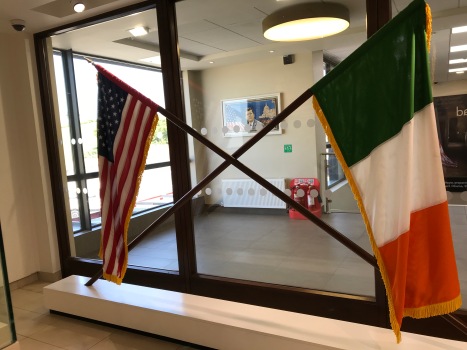


Dublin, Ireland’s capital city, is bustling and full of historical reminders and culture of every sort. Like in most of Ireland, one of the most popular activities is going to a pub, and it seems that Dublin has thousands of pubs, all very popular.


Probably one of the most popular and well-known (and touristy) areas in the city is Temple Bar. This area has shops, cafes, theaters, pubs with live music, galleries, live music on the streets, and restaurants galore. It’s on the south bank of the River Liffey, and many people call it Dublin’s “Left Bank”. Most, if not all, visitors to Dublin like to go to Temple Bar to see for themselves what the hype is all about. We are no exception, as on our visits to the city at different times we always like to go to the Temple Bar area, as it is a lot of fun.


First, what does the name mean? Some people tried to tell us that it was an area linked to many law firms—hence bar—but this is not correct. It’s also not actually originally linked to bars and pubs. About four hundred years ago this was the city’s waterfront, where tall sailing ships offloaded their goods. A “bar” was a loading dock along the river, or a walkway along the river in Irish language. The Temples were a dominant merchant family who owned this whole area of Dublin, and the words Temple and bar became joined. A plaque on Temple Bar Street (by the shop linked to the Temple Bar) explains about Sir William Temple (1555-1527) and his acquisition of the land right here. Another plaque in the Temple Bar is dedicated to Lady Martha Temple. The Temple Bar area became a thriving Georgian center of merchants and craftsmen, but it fell on hard times in the early 20th century.



Over time the city grew eastward and filled in tidal mudflats, which created the docklands of modern Dublin further downstream. Rents became much lower in Temple Bar area, so students and artists were attracted here. In more recent years the government has offered tax incentives and development money, so this area has developed into a thriving entertainment district.


The center of this area is Temple Bar Square, just off Temple Bar Street, which is near the famous Ha’Penny Bridge. You can start there, but it’s fun to just wander along the many cobblestone streets. It’s very crowded, especially in the evenings, and can get pretty rowdy as the night progresses, so you need to be aware. Find a pub or café that has an open spot and settle for some serious people-watching and music-listening. It is fun, but a couple of nights there was enough for us, I think! I suggest that early afternoon is best before the crowds really get going.




The Ha’Penny Bridge is a charming elliptical arch bridge over the River Liffey, built in 1816 just for pedestrians and it was the first iron bridge in Ireland. Before it was built, people had to either get on a small ferry across the river or else vie with horse carriages and carts on the other bridges. The name comes from the price: it cost a ha’penny (half penny) to cross the bridge, the same amount that people paid for the ferry. They stopped charging this in 1919, at which time it cost one and a half pennies to cross. The bridge has had various names over the years (such as Wellington and Liffey), but this is the one that has stuck. At first, about 450 people crossed it daily; nowadays that number is about 30,000, and it’s free. As with so many bridges around the world, people put locks on the bridge, but these so-called “love locks” are damaging the bridge, so the Dublin City Council has banned locks, but somehow some people still put locks on the bridge. Here are a few that we saw last time!


One of the famous pubs in this area is called the Temple Bar. The Temple Bar is an institution in Dublin, so we had to try it.

The Temple Bar has been a quintessential Dublin pub since 1840, and prides itself on having the largest collection of whiskies (from Ireland, Scotland and other countries) in Ireland. It’s very popular and busy and hard to find seats, but luckily we did both times that we came. It’s loud and crowded, but we’re happy that we came and could experience the vibe (called craic in Irish) here. The bar is also well-known for live Irish music, with no cover charge, and we did get to listen to two different sessions. The bar has been awarded the title “Traditional Music Pub of the Year” every year since 2002.

The pub is huge, with different interleading rooms, including an open beer garden in the center, so it’s fun to wander around and have a look. The beer and wine here are not cheap, but Dublin (and Ireland generally) is not cheap. Some of our party tried a Smithwicks Irish ale, one of Ireland’s special beers, and said it was pretty good. The bar also has an Oysters and Guinness speciality, and a large menu of sandwiches, cheeses, and salmon dishes, but we didn’t eat here.
Find it at 47/48 Temple Bar Street, www.thetemplebarpub.com


